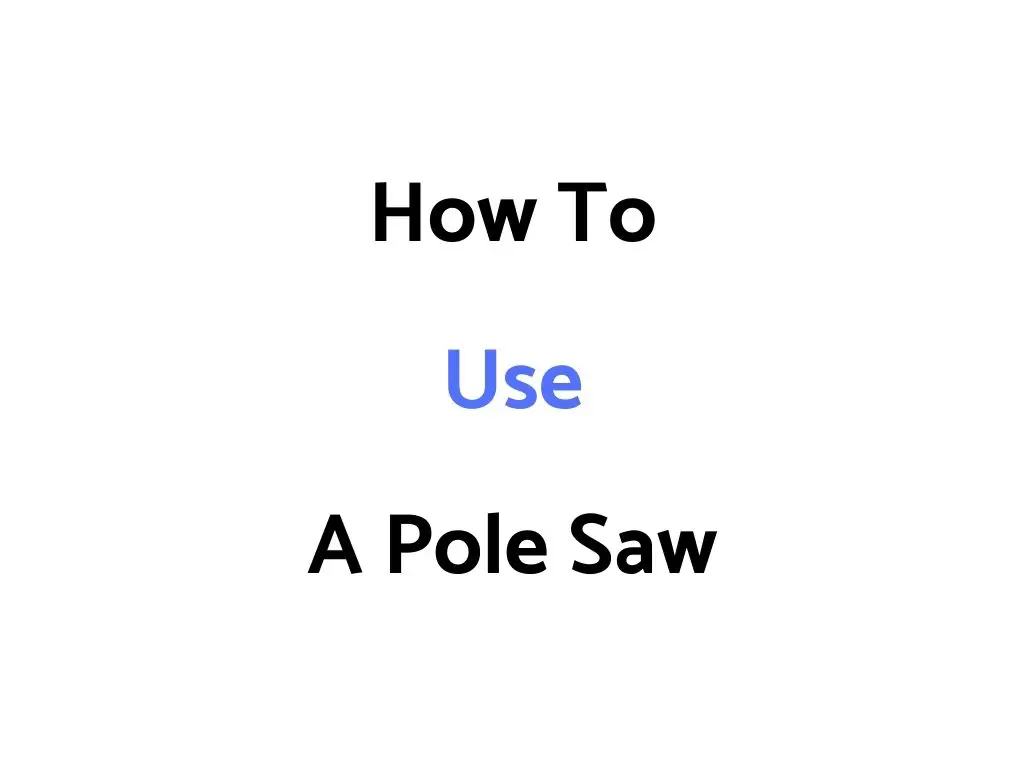If you are just learning how to use a pole saw, you should be aware they were mainly designed to cut branches overhead up to 8-10 inches thick, which would usually be unreachable from the ground with any other tool.
Cutting branches overhead can be dangerous, so there are safety precautions we’ve listed below which you might find useful.
And in terms of operation, a power pole saw and manual pole saw are used slightly differently (with different pros and cons), so you should be aware of those differences which we’ve also brought to your attention.
(*Note – this is a general information guide only, and not professional advice. Do your own research about proper safety prior to using a pole saw.)
How To Use A Pole Saw – Operating Techniques & Steps
1. Check the bar/chain has enough lubricating oil, and check your pole saw is maintained properly (mainly the pole is stable when locked in place, and the bar/chain is in good condition)
2. Assess the task you are undertaking, and plan out your cuts in advance – how many branches are there to cut? are there any restrictions on the area you are cutting in? what is the wood like…soft, or dry/hard? How can you minimise damage to the tree and environment?
3. Extend the pole saw to the desired length, and lock pole and saw attachment into position.
4. Start the pole saw on the ground away from branches. Press the trigger a few times to make sure it’s running correctly
5. Begin cutting – cut from an angle, and score the branch from the underside if its a thicker branch, followed by the top side cut. Cut just slightly out from the collar/branch base
If using a manual pole saw, make sure to use the saw hook is in contact with any larger branches when you make the top cut so you have more control
6. Clean up cut branches
Power Pole Saws vs. Manual Pole Saws Operation Differences
There are a few small differences in using a power pole saw vs. a manual pole saw:
There are a few different types of power pole saws – electric/corded, battery operated & gas powered
Power pole saws can be heavy when using at an angle which is too horizontal to the ground – try to keep the weight of the saw more vertical, and get a pole saw with a harness if necessary to distribute the load away from your arms and shoulders
Manual pole saws are generall much longer (extend up to 4-5 metres) , and much lighter (better for extended periods of cutting)
Manual pole saws have hooks at either end of the saw to keep the saw on the branch and for control when felling the branches
If you are a professional, it might be worth having both a power saw and a manual pole saw, as manual saws give you a longer reach and can be better in thicker canopies for access
Safety Tips For Operating A Pole Saw
Operating a pole saw can be dangerous if you don’t know what you’re doing. Here are some safety tips you might choose to take into consideration:
Wear the appropriate safety equipment – helmet, protective eye glasses, gloves (important for vibration), and earplugs if required
Make yourself aware with the safety standards for cutting with a pole saw, and for cutting trees in your area. Are arborist permits or licenses required for the work you want to perform?
Never cut tree branches directly overhead – always stand a safe distance away from the direct fall zone of the branch, or the zone in which it may rebound off other branches and fall
Be careful of spring back from branches – under tension, wood can spring in the opposite direction when cutting pressure is released. Be wary of this when cutting
Be careful of kickback from the saw when the chain stalls
Don’t cut near power lines or other overhead hazards
If other people are in the area you are cutting – make sure you flag off the area so they walk around the hazard zone at a safe distance. Around 15m for an exclusion zone is a safety area.
Take regular breaks to prevent fatigue and neck/shoulder/arm and other strains and injuries – especially with power pole saws
Always perform a check on the condition of the pole, and condition of the saw/chain before you begin use – replace worn down chains, and faulty poles
Clear the area you are cutting in of ground hazards that you could trip on
If you are doubting your experience or ability, call in a professional – especially for thicker branches of 8-10 inches plus
For bigger branches, the branch into smaller sections, instead of starting at the base of the branch near the tree
For corded pole saws, make sure to keep the cord from tangling up
Don’t cut with a corded pole saw when its wet or its been raining outside
Only cut during the day time when you have sufficient light to see what you’re doing
Note that pole saws are mainly intended for cutting branches, and not upright plants or trees growing out of the ground
Who Makes The Best Pole Saw
If you are looking for a new pole saw or pole saw attachment, you might be interested in the following articles with buying information such as a buyer’s guide, reviews and buying options on pole saws:
Best Pole Saw: Buyer’s Guide & Reviews
Pole Saw Attachment vs. New Pole Saw: 4 Best Options To Consider When Buying
How To Use A Pole Saw: Resources
1. http://tooljuice.com/best-pole-saw-buyers-guide-reviews/
2. http://tooljuice.com/pole-saw-attachment-vs-new-pole-saw-4-best-options-consider-when-buying/

